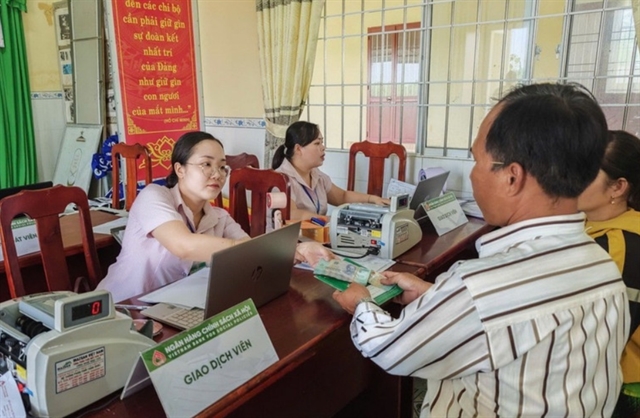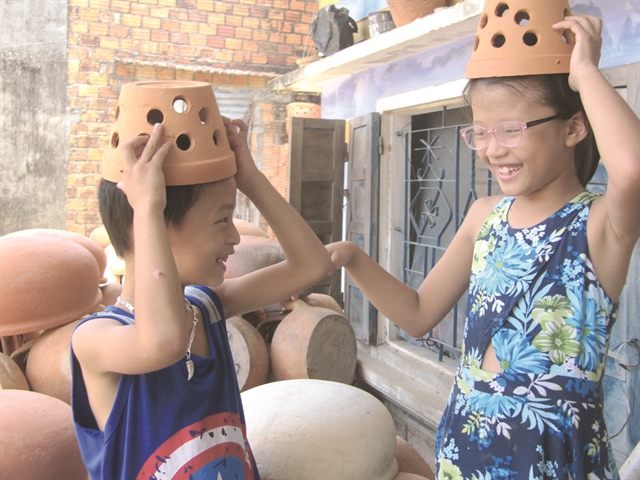

Many people at the bottom of Dâu Mountain once made pots from clay, that had the colour of earth. Now only ten families still make them.

|
| PLAYFUL POTTERY: Children play with flower pots at a family workshop in Vĩnh An Village of Phổ Khánh Commune. Youngsters are involved with the craft from an early age. VNS Photo Công Thành |
Situated at the foot of Dâu Mountain, many earthenware potters in Phổ Khánh Commune in the southern central province of Quảng Ngãi still earn a living from the traditional trade despite rapid urbanisation.
Earthenware potteries, once forgotten years ago in favour of plastic alternatives, have recently become popular again among rural restaurants.
What used to be a busy pottery hub, 60km south of Quảng Ngãi City, with 300 households producing earthenware in the late 1970s, now consists of 10 families and a dozen skilled potters.
The potters, now in their later years, are struggling to keep the trade alive as youngsters follow other trades looking for better money.
Kitchenware, including jars, bowls and pots, was the main products of the commune, with prices ranging from VNĐ20,000 (nearly US$1) to VNĐ40,000 ($1.7) per item. At least 10,000 pieces were sold each month at markets in the provinces of Bình Định, Quảng Nam, Quảng Ngãi and Thừa Thiên-Huế.
Nguyễn Tấn Hợp, 35, the owner of a pottery workshop in the commune, said the trade has provided a regular income for his family since his great-great-grandfather, and still creates jobs for some old potters in the commune who earn around VNĐ200,000 ($8.7) per day.
“I learned the trade from my maternal grandfather and mother. My mother was a skilled potter in the commune, but she retired due to old age. However, I have recovered the family trade in recent years as earthenware products started to become more popular again,” Hợp said.
“Clay pots and firewood stoves, which were replaced by gas and electric ovens, have lured chefs as they provide a more natural aroma to the food,” he explained.
He said some restaurants in the city use clay pots to cook food in a unique style.
Old potters
Hợp’s mother, Phan Thị Hà, 75, recalled that women with skilful hands were assigned to form wet clay on the potter's wheel into pots and dry them in the sunlight, while men did heavier jobs such as digging and kneading clay as well as placing the raw products in the kiln.
Hà said pottery was her childhood and helped the family get through difficult times, and the tradition was now being kept alive by her son.
“Women were masters of the wheel – where potteries are formed by their gentle hands,” she said.
“Earthenware products were used by people in rural areas as water containers, cooking pots, jars and stoves, as peasants often cooked food with firewood, thatch and dry leaves,” she said.
The old woman said gas ovens are now commonplace, but rural communities still prefer the traditional way.
Hợp said the Phổ Khánh earthenware can be told apart from those of other villages as it does not use enamel.
“We mixed grey clay and yellow clay with an appropriate ratio before shaping it into pots on wooden wheels. The work must be done in the dry season, and production often ends before rain starts in late October,” Hợp said.
“In speeding up the process for mass production, manual wheels were replaced by machines, and women would only trim wet clay after it is formed,” he said.
He said brick kilns at the family-owned pottery are used every week to produce thousands of items to order.
He said baking kilns take 12 to 13 uninterrupted hours at temperatures of over 1,000 degrees Celsius, creating unique colours for the Phổ Khánh terracotta.
Hợp’s father, Nguyễn Trung Thuật, 78, said making clay was a hard job for men.
“We have to dig deep to find the best clay before drying it in the sun for days. We then mixed different clay (yellow and grey) with water. Smooth clay helps make fine products,” Thuật said.
He said he has retired from the trade to look after his grandchildren and help his son with odd jobs.
Lê Thị Chương, 59, from Vĩnh An Village, said she had been working at the pottery since the early 1990s.
“My family also make terracotta, but the trade could not compete against jobs offering higher incomes. Young people can earn more from masonry, fishing or mechanics, so pottery is the only option for old people,” she said.
“We could not make money from other jobs after rice farming, livestock feeding or pottery. Anyway, I'm almost addicted to the smell of clay since I was born and grew up in the village. I love touching clay at least once a day.”
Vĩnh An and Trung Sơn are two of the only villages in the commune that continue the trade.
Ancient culture
Archaeologist Đoàn Ngọc Khôi said today's pottery trade in Phổ Khánh Commune was rooted in the Sa Huỳnh Culture (from 2,500 to 3,000 years ago).
He said communities of the Sa Huỳnh Culture had settled around An Khê Lake, and the trade emerged.
Pottery continued to be done by the Chăm people and then the Việt (Vietnamese majority people).
“The craft in Phổ Khánh Commune has progressed from that of the Sa Huỳnh and Chăm people. Ancient potters used their hands to form items, not wooden wheels,” Khôi explained.
“Ancient people used a stone fragment to trim or smooth the surface of the clay before baking, while now Phổ Khánh potters use a wooden knife,” he said.
“Vietnamese potters today share the same skills as ancient craftsmen. The process has been accelerated with machinery,” he said.
Khôi said Sa Huỳnh and Chăm people baked clay outdoors, but they did not use kilns with lower temperatures.
He said Sa Huỳnh and Chăm potters mixed sand, rock and plants with wet clay – contrasting to how the terracotta of modern Phổ Khánh potters is made.
“Pottery is part of the heritage of the Sa Huỳnh Culture. Many artefacts of the Sa Huỳnh Culture and Champa Kingdom are similar to modern potteries in colour and design, as well as the methods used to make them,” Khôi said.
The commune has undergone a facelift, with infrastructure booming along National Highway 1 and the Trans-Việt Nam railway in the last couple of decades, while potters hold tight to their manual craft.
“Clay work is part of our lives. It brings happiness to the community. We hope the trade will continue and is taken up by the next generation, but there needs to be renovation and changes in production,” pottery artisan Chương said. — VNS
GLOSSARY
Situated at the foot of Dâu Mountain, many earthenware potters in Phổ Khánh Commune in the southern central province of Quảng Ngãi still earn a living from the traditional trade despite rapid urbanisation.
The foot of a mountain is the bottom of a mountain.
Urbanisation is the process that involves country areas becoming city areas.
Earthenware potteries, once forgotten years ago in favour of plastic alternatives, have recently become popular again among rural restaurants.
An alternative is something that can be used in place of something else.
Rural means to do with country areas.
What used to be a busy pottery hub, 60km south of Quảng Ngãi City, with 300 households producing earthenware in the late 1970s, now consists of 10 families and a dozen skilled potters.
A hub is a place where there are lots of activities and to which people go for the activities.
A dozen means many but technically it means twelve.
The potters, now in their later years, are struggling to keep the trade alive as youngsters follow other trades looking for better money.
Trades are jobs.
Nguyễn Tấn Hợp, 35, the owner of a pottery workshop in the commune, said the trade had provided a regular income for his family since his great-great-grandfather, and still creates jobs for some old potters in the commune who earn around VNĐ200,000 ($8.7) per day.
If you have a regular income you get money at much the same time, usually at the end of each month.
Nguyễn Tấn Hợp, 35, owner of a pottery kiln in Phổ Khánh Commune, removes terracotta pots from a kiln.
A kiln is a special oven used in the making of pottery.
Terracotta is a type of fired clay, usually brownish-red in colour.
“I learned the trade from my maternal grandfather and mother.
Your maternal grandfather is your mother’s father.
My mother was a skilled potter in the commune, but she retired due to old age.
When someone retires they stop working because they have reached a certain age.
“Clay pots and firewood stoves, which were replaced by gas and electric ovens, have lured chefs as they provide a more natural aroma to the food,” he explained.
Lured means attracted.
Aroma means smell.
He said some restaurants in the city use clay pots to cook food in a unique style.
If something is unique there is only one of it in the world.
Hợp’s mother, Phan Thị Hà, 75, recalled that women with skilful hands were assigned to form wet clay on the potter's wheel into pots and dry them in the sunlight, while men did heavier jobs such as digging and kneading clay as well as placing the raw products in the kiln.
To be assigned means to be given a particular job to do.
To knead means work clay into a paste with your hands.
“Earthenware products were used by people in rural areas as water containers, cooking pots, jars and stoves, as peasants often cooked food with firewood, thatch and dry leaves,” she said.
Peasants are village farmers.
Thatch is grass used on the roofs of houses.
The old woman said gas ovens are now commonplace, but rural communities still prefer the traditional way.
If gas ovens are commonplace, many people have them. It’s the same as saying that they are common.
“We mixed grey clay and yellow clay with an appropriate ratio before shaping it into pots on wooden wheels.”
An appropriate ratio is a correct mix.
“In speeding up the process for mass production, manual wheels were replaced by machines, and women would only trim wet clay after it is formed,” he said.
Mass production means making many of something.
Manual means operated by hand.
He said baking kilns take 12 to 13 uninterrupted hours at temperatures of over 1,000 degrees Celsius, creating unique colours for the Phổ Khánh terracotta.
Uninterrupted hours, in this case, would be hours when the temperature stays at more than 1,000 degrees without changing.
“Young people can earn more from masonry, fishing or mechanics, so pottery is the only option for old people,” she said.
Masonry is building, especially using stones and bricks.
An option is a choice.
“Anyway, I'm almost addicted to the smell of clay since I was born and grew up in the village.”
If you are addicted to something you absolutely have to have it every day.
Archaeologist Đoàn Ngọc Khôi said today's pottery trade in Phổ Khánh Commune was rooted in the Sa Huỳnh Culture (from 2,500 to 3,000 years ago).
An archaeologist is someone who knows a lot about and studies ancient civilisations.
Rooted means “originated”.
“The craft in Phổ Khánh Commune has progressed from that of the Sa Huỳnh and Chăm people.”
Progressed means “gone forward”.
“Ancient people used a stone fragment to trim or smooth the surface of the clay before baking, while now Phổ Khánh potters use a wooden knife,” he said.
A stone little fragment is a piece of stone.
“The process has been accelerated with machinery,” he said.
Accelerated means “speeded up”.
He said Sa Huỳnh and Chăm potters mixed sand, rock and plants with wet clay – contrasting to how the terracotta of modern Phổ Khánh potters is made.
Contrasting means “making itself appear different”.
“Many artefacts of the Sa Huỳnh Culture and Champa Kingdom are similar to modern potteries in colour and design, as well as the methods used to make them,” Khôi said.
Artefacts are things left behind from the past.
The commune has undergone a facelift, with infrastructure booming along National Highway 1 and the Trans-Việt Nam railway in the last couple of decades, while potters hold tight to their manual craft.
A facelift is a new look.
Infrastructure is made up of roads, railway lines, harbours and other things a country needs to have to make it work.
Decades are periods of ten years.
“We hope the trade will continue and is taken up by the next generation, but there needs to be renovation and changes in production,” pottery artisan Chương said.
You and your brothers and sisters are one generation; your parents and aunts and uncles are another and your children are yet another, and so on.
Renovation means “fixing up”or “making new”.
WORKSHEET
Find words that mean the following in the Word Search:
f | f | t | u | d | e | o | s | e | P |
k | a | t | o | e | m | r | y | h | L |
i | t | o | r | r | e | i | e | w | A |
h | h | g | u | t | l | e | o | y | S |
s | e | a | s | t | t | r | a | y | T |
d | r | o | y | m | h | s | n | c | I |
c | h | e | f | s | h | o | o | d | C |
r | l | c | p | o | t | t | e | r | S |
ANSWERS: 1. Degree; 2. Father; 3. Potters; 4. Plastic; 5. Chefs.



